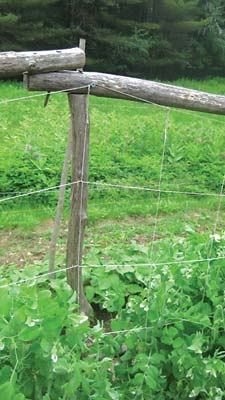 |
| Photo 1. Pole and crossbars used to trellis beans, peas and cucumbers |
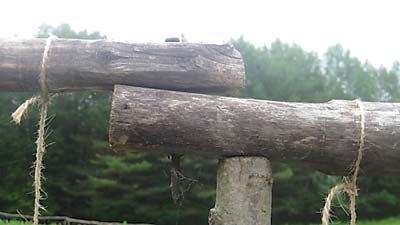 |
| Photo 2. A spike inserted through two holes where crossbar ends overlap holds crossbars together. |
By Tom Vigue
Photos by the author
A number of common garden crops benefit greatly from trellising. Crops that do not directly contact the soil and that have vastly improved air circulation are much more resistant to disease pressure. Quality is improved, yield is increased, and the gardener benefits from space saving and neatness. Also, if you do end up having to spray a crop for disease or insect control, having it up on a trellis makes good coverage much easier to achieve.
The crops I’m referring to are cucumbers, pole beans, peas and tomatoes. They differ in their growth habits, so I use different approaches to provide a proper trellis for each. Cukes, beans and peas can be supported by wood poles and wood crossbars, each with a different method of stringing or netting. Tomatoes, however, are much heavier than the other three, so I resort to metal.
Photos 1 and 2 illustrate the basic structure of poles and crossbars used for peas, beans and cukes. The upright pole has a 5/16-inch hole drilled into its top. This hole provides a loose fit for a galvanized 20-penny spike. The crossbar ends are flattened top and bottom for about 6 inches of their length. Into this part of the crossbar, I drill two 5/16-inch holes, about 2 inches apart. Through one of these holes, I insert a spike into the top of the upright pole. The second hole provides an attachment point for the next crossbar in a series, simply by inserting a spike through two holes where crossbar ends overlap (photo 2).
I drive the upright poles into the ground. In my garden a depth of about 18 inches works well. If you have heavy clay soil, 12 inches may suffice. In extremely soft, friable soil, 24 inches may be needed. In practice, therefore, I use a 7-1/2-foot pole for a 6-foot-high trellis.
Many species of sapling, 2 to 2-1/2 inches in diameter at their bases, will provide good pole material. Avoid birch, cherry and poplar, as they are weak and deteriorate rapidly. Peeling the bark off the part that is driven into the ground will prolong their useful life. Scorching this part of the pole will prolong its life even more. (See the 2015 book “Will Bonsall’s Essential Guide to Radical, Self-Reliant Gardening” for a detailed discussion of scorching as a wood preserving method.)
When using a pole for a second or perhaps a third time, first attempt to break it. Seriously. Bash it on the ground as hard as you can. If it breaks, it is beyond use; much better that you broke it before it broke while in use.
Crossbars have a much longer useful life, since they never touch the ground. If they are entirely peeled, they can last five or six years easily; I have had some last as long as 10 years. They are, of course, stored under cover when not in use.
To facilitate driving poles into the ground, first make a pilot hole with a heavy bar. Spacing of the poles, and therefore the length of crossbars, can vary with the crop. For peas and cukes I use a 10-foot span. Beans have a much denser foliage for a much longer season and can experience a lot more wind pressure, so for these I use an 8-foot span. (Note: In his 1992 book, “Four-Season Harvest,” Eliot Coleman discusses a pole- and crossbar-type trellis made with milled lumber.)
Photo 3 shows ‘Schweitzer Riesen’ snow peas (my favorite snow pea) climbing a trellis netted with Trellis Plus – a 7-inch-mesh nylon netting available from many suppliers. It hangs from the top bar with screws. Use 1-1/4-inch weatherproof construction screws for this, spaced about 2 feet apart. Pull the net tight to the end poles the same way. To keep the bottom of the net tight, you can “hook” it to the ground. A 2-foot length of branch with a 3-inch stub of a side branch protruding makes a handy hook. Hook the side branch over the bottom strand of net and push the branch deeply into the soil. Space these ground hooks about every 2 feet. Branches from firewood harvesting, tree pruning, etc., provide an endless resource for these. With care you can reuse Trellis Plus for many seasons. Pea tendrils pull off easily when it’s time to clean and store the net. For storage, gather the strands at the ends of the net together and wrap them with brightly colored tape. The tape prevents tangling and makes it easy to find the ends for reuse. Once taped, roll the net up on a spindle or tube, being careful not to twist it at all.
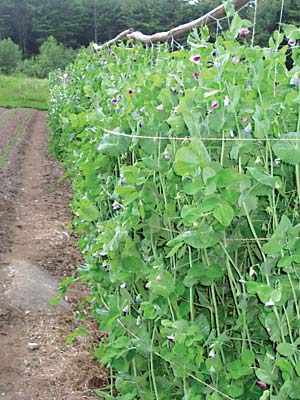 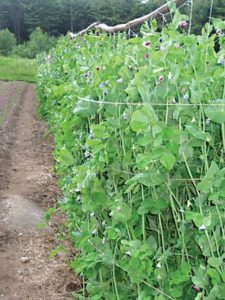 |
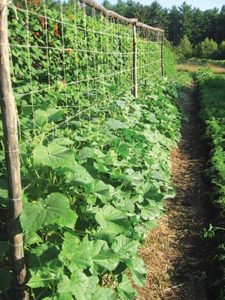 |
|
| Photo 3. ‘Schweitzer Riesen’ snow peas climb a trellis netted with Trellis Plus. | Photo 4. A 20-foot-long cucumber trellis, with jute twine strung to create 7-inch squares | |
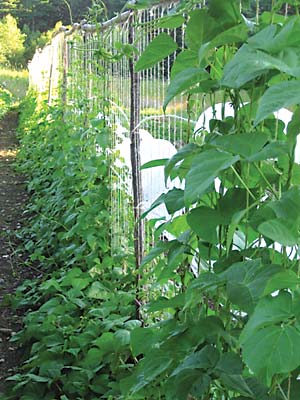 |
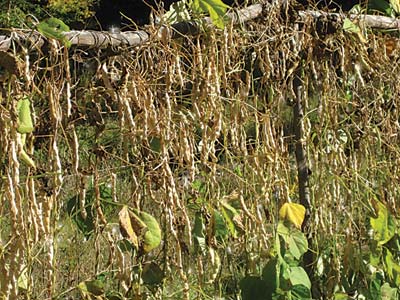
I plant peas in a wide band. Tendrils of plants near the middle of the band will hold tightly to the net, and plants a few inches away will hold tightly to the other plants. Together they will climb happily. However, peas have notoriously fragile stems. The wind and driving rain of thunderstorms can easily rip tendrils off the net, resulting in a discouraging mess. To prevent this, string jute twine along the outside of the planting and tie it to the poles (photo 3). If the twine is too tight, it will bend the stems. It should be just snug enough to confine the mass of plants, preventing them flopping over when laden with rain. Put this twine 1 to 2 feet apart, as dictated by the weight of the plants. If the twine is tied to the poles with a releasable knot, you can adjust its tautness. As plants grow, new branches will often grow outside the twine; so periodically you can release the twine, pulled it out and replace it, gathering the new growth in the process. |
Photo 4 shows a 20-foot-long cucumber trellis. Cucumbers showcase all the reasons for using trellises. First, trellising saves space. The trellis shown supports 18 plants occupying 20 feet of a 3-foot-wide bed – only 60 square feet of garden space. Those same plants left on the ground would easily spread to 12 feet wide and occupy 240 square feet of space. Getting the plants up off the ground prevents, or at least significantly delays, the onset of foliar diseases due to increased air circulation and quicker drying after rains. The fruits remain clean, free of slug damage, and long-fruited types produce straighter fruits. The planted area is completely accessible for weeding, or better, mulching, and requires one-fourth as much mulch. Finding and picking the fruit is much easier, since it is in front of you instead of underfoot.
Trellis Plus would work fine for cukes, but I worry more about diseases with them than I do with peas; so I use jute twine, strung in the same 7-inch-square pattern. At season’s end a utility knife easily slices the twine neatly off the poles, and spent plants and twine can be composted together.
To tie this trellis, first string the horizontals and then hang the verticals, tying them to the horizontals with a clove hitch or some modification of that common knot. The process is quick and the trellis is very stable. Once plants begin to climb, they occasionally need some training to prevent branches from going off on a tangent seeking other things to latch on to. Simply shove the branches through the 7-inch-square holes; the tendrils will grab on to the twine quickly.
Look at the enormous productivity of the pole dry beans in photo 5! And pole snap beans, if kept faithfully picked, will produce unbelievable quantities until frost kills the plants. Rarely is a speck of mold on them, and dirt never clings to them. Photo 6 shows pole beans racing up their trellis, different varieties at different rates. Note that since beans climb by twining rather than by tendrils, they need a large number of vertical strings with only two, or at most three, horizontal strings to stabilize the whole. One horizontal should be close to the ground, then one halfway up, or two at thirds. The verticals are about 4 inches apart, about a handspan. Two rows of beans are planted, one on either side of the trellis, with the rows about 8 inches apart. The cucumber photo (photo 4) shows, beyond the cucumber strings, a “wall” of pole beans filling their trellis. Included in the bean trellis are a few ‘Scarlet Runner’ beans, used as markers between other varieties and to attract hummingbirds.
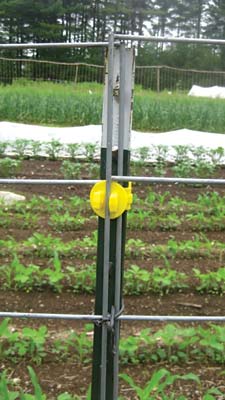 |
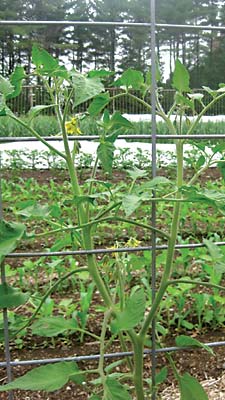 |
| Photo 7. Cattle panels hang on insulators until they are secured to T-posts with wire. | Photo 8. Stems of a young tomato plant are trained to go through openings in cattle panel. |
One reliable source for quantities of jute twine has been Uline (uline.com), which carries a 10-pound spool of 3-ply, approximately 5,000 feet. Home Depot has a 10-pound 2-ply, 7,700 feet. Both cost around $25. Sisal baling twine, another option, is coarse for the hands and so a little slower to tie, but works well.
For tomatoes, because of their weight, I resort to cattle panel and T-posts. The panels are 5-feet x 16-feet. I drive 6-1/2-foot-long T-posts in deep enough for stability at a spacing of 8 feet. Sections of panel can hang temporarily on T-post fence insulators (photo 7) until the panels are wired securely. The wires and nubs on the posts do all the work of carrying the weight. Space plants 2 to 3 feet apart and train them through the sections of panel, so that the stems go from one side to the other (photo 8). This system helps keep foliar diseases at bay and facilitates spraying if you go that route. Again, the fruit is far from slugs and soil. Checking ripeness and picking are easy.
Disease-causing organisms can overwinter on panels and posts, so they should be disinfected at the end of each season. A 12x dilution of household bleach can be used for this. Please do this outside the garden. Note that organic growers must use only sanitizers and disinfectants that meet National Organic Standards. For guidance, see “Coming Clean on Sanitizers in Organic Production” at https://www.mofgacertification.org/wp-content/uploads/comingcleanonsanitizerssum2011.pdf.
For more on using cattle panel for trellis, see Adam Tomash’s article “In Search of the Perfect Tomato Trellis” in the winter 2008-2009 issue of The Maine Organic Farmer & Gardener.
About the author: Tom Vigue, his wife, Eileen Fingerman, and daughter, Kira, live a vegan lifestyle at Kiwihill Farm in Sidney, Maine. Their 1/4-acre garden and extensive fruit plantings produce much of the food they consume. Their owner-built, passive solar, stone house keeps them warm in winter, cool in summer.

